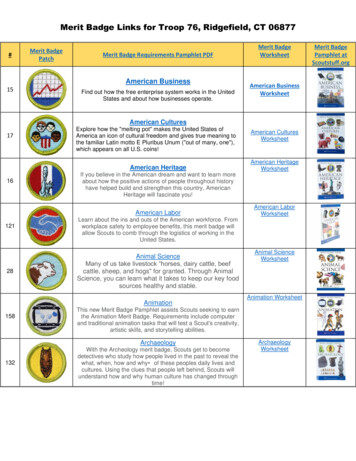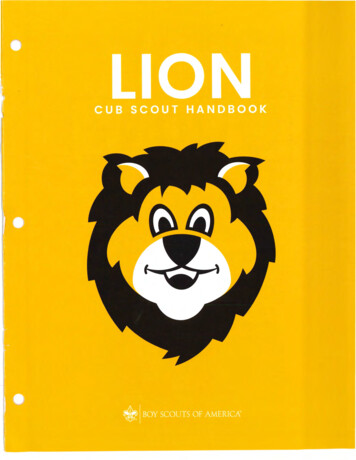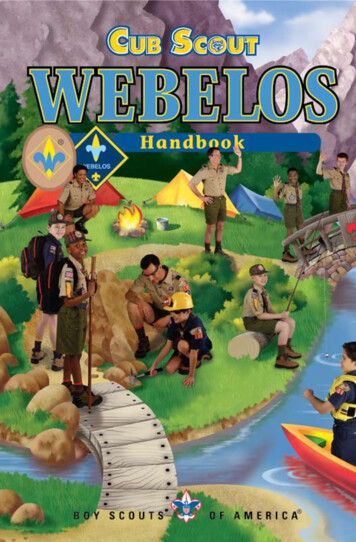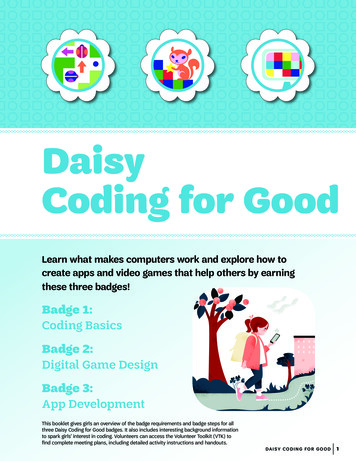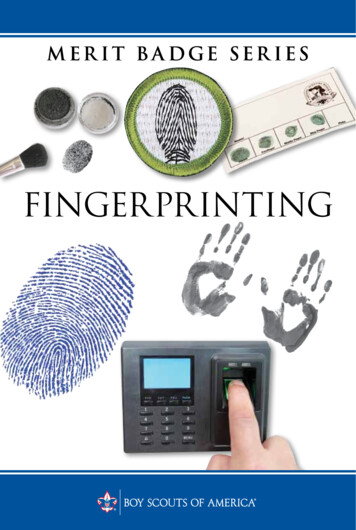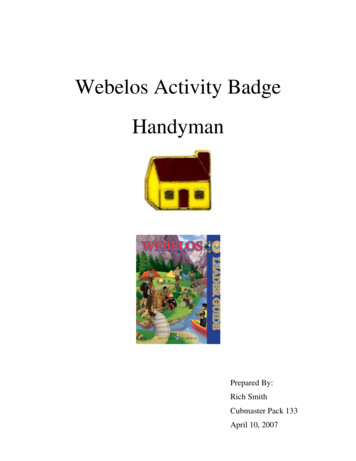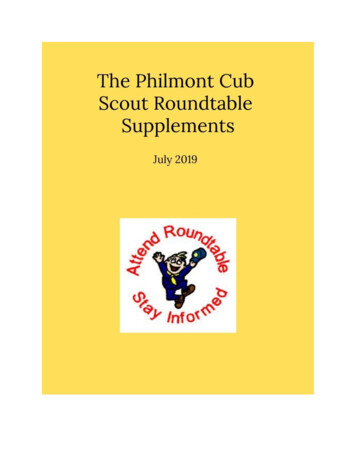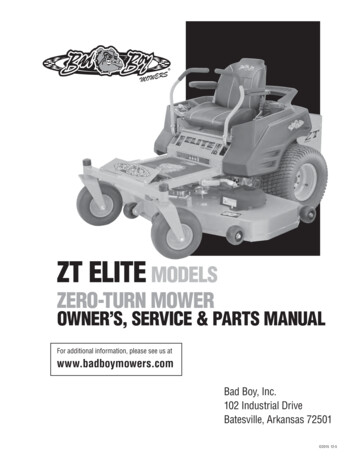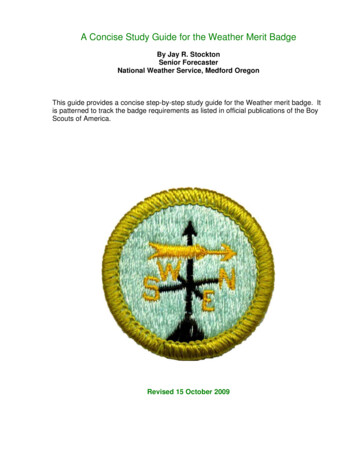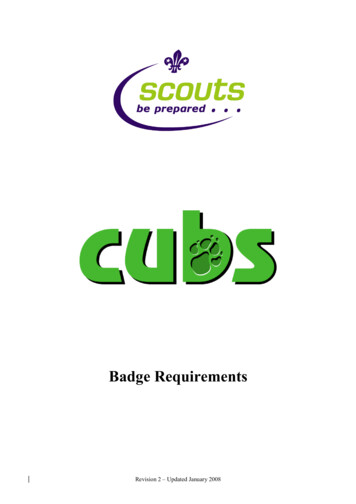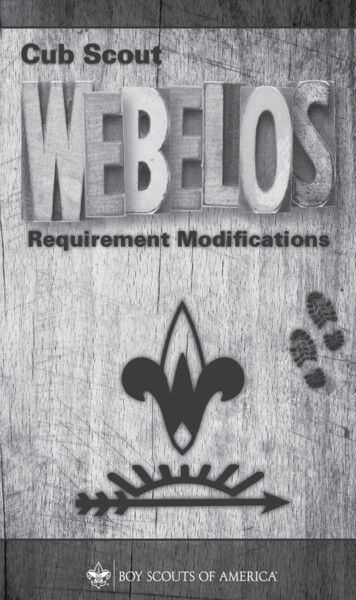
Transcription
WEBELOS BADGE REQUIREMENTS(EFFECTIVE DECEMBER 2016)Rank advancement is awarded when each Scout has done the following:1. Be an active member of your Webelos den for three months.2. Complete each of the five required adventures. (Specific requirements for theseadventures can be found in this addendum.) Cast Iron Chef Duty to God and You First Responder Stronger, Faster, Higher Webelos Walkabout3. In addition to the five required adventures listed above, complete at leastone elective adventure of your den’s or family’s choosing (for a total of at leastsix adventures).4. With your parent, guardian, or other caring adult, complete the exercises in thepamphlet How to Protect Your Children From Child Abuse: A Parent’s Guide.5. Earn the Cyber Chip award for your age. (The Cyber Chip portion of this requirementmay be waived by your parent or guardian if you do not have access to the internet.)ARROW OF LIGHT REQUIREMENTS(EFFECTIVE DECEMBER 2016)Rank advancement is awarded when each Scout has done the following:1. Be active in your Webelos den for at least six months since completing the fourthgrade or for at least six months since becoming 10 years old.2. Complete each of the four required adventures. (Specific requirements for theseadventures can be found in this addendum.) Building a Better World Duty to God in Action Outdoorsman (formerly Camper)—Option A (including a campout) OR Option B(including an outdoor activity) Scouting Adventure3. In addition to the four required adventures listed above, complete at least oneelective adventure of your den’s or family’s choosing (for a total of at leastfive adventures).4. With your parent, guardian, or other caring adult, complete the exercises in thepamphlet How to Protect Your Children From Child Abuse: A Parent’s Guide.5. Earn the Cyber Chip award for your age. (The Cyber Chip portion of this requirementmay be waived by your parent or guardian if you do not have access to the internet.)2
Webelos Required AdventuresCast Iron ChefComplete requirements 1 and 2 below. Requirement 3 is optional.Requirement1. Plan a menu for a balanced meal for your den or family. Determine the budget for themeal. If possible, shop for the items on your menu. Stay within your budget.2. Prepare a balanced meal for your den or family. If possible, use one of these methodsfor preparation of part of the meal: camp stove, Dutch oven, box oven, solar oven,open campfire, or charcoal grill. Demonstrate an understanding of food safetypractices while preparing the meal.3. Use tinder, kindling, and fuel wood to demonstrate how to build a fire in anappropriate outdoor location. If circumstances permit and there is no local restrictionon fires, show how to safely light the fire, under the supervision of an adult. Afterallowing the fire to burn safely, safely extinguish the flames with minimal impact tothe fire site.Duty to God and YouComplete requirement 1 and at least two others.Requirement1. Discuss with your parent, guardian, den leader, or other caring adult what it means todo your duty to God. Tell how you do your duty to God in your daily life.2. Earn the religious emblem of your faith that is appropriate for your age, if you havenot done so already.3. Discuss with your family, family’s faith leader, or other trusted adult how planningand participating in a service of worship or reflection helps you live your duty to God.4. List one thing that will bring you closer to doing your duty to God, and practice it forone month. Write down what you will do each day to remind you.First ResponderComplete requirement 1 and at least five others.Requirement1. Explain what first aid is. Tell what you should do after an accident.2. Show what to do for hurry cases of first aid: serious bleeding, heart attack or suddencardiac arrest, stopped breathing, stroke, poisoning.3. Show how to help a choking victim.4. Show how to treat for shock.5. Demonstrate how to treat at least five of the following:A. Cuts and scratchesB. Burns and scaldsC. Sunburn3
D. Blisters on the hand or footE. Tick bitesF. Bites and stings of other insectsG. Venomous snakebitesH. NosebleedI. Frostbite6. Put together a simple home first-aid kit. Explain what you included and how to useeach item correctly.7. Create and practice an emergency readiness plan for your home or denmeeting place.8. Visit with a first responder or health-care professional.Stronger, Faster, HigherComplete requirements 1–3 and at least one other.Requirement1. Understand and explain why you should warm up before exercising and cool downafterward. Demonstrate the proper way to warm up and cool down.2. Do these activities and record your results: 20-yard dash, vertical jump, lifting a5-pound weight, push-ups, curls, jumping rope.3. Make an exercise plan that includes at least three physical activities. Carry out yourplan for 30 days, and write down your progress each week.4. Try a new sport that you have never tried before.5. With your den, prepare a fitness course or series of games that includes jumping,avoiding obstacles, weight lifting, and running. Time yourself going through thecourse, and try to improve your time over a two-week period.6. With adult guidance, help younger Scouts by leading them in a fitness gameor games.Webelos WalkaboutComplete requirements 1–4 and at least one other.Requirement1. Plan a hike or outdoor activity.2. Assemble a first-aid kit suitable for your hike or activity.3. Recite the Outdoor Code and the Leave No Trace Principles for Kids from memory.Talk about how you can demonstrate them on your Webelos adventures.4. With your Webelos den or with a family member, hike 3 miles. Before your hike, planand prepare a nutritious lunch or snack. Enjoy it on your hike, and clean up afterward.5. Describe and identify from photos any poisonous plants and dangerous animals andinsects you might encounter on your hike or activity.6. Perform one of the following leadership roles during your hike: trail leader, first-aidleader, or lunch or snack leader.4
Arrow of Light Required AdventuresBuilding a Better WorldComplete the following requirements.Requirement1. Explain the history of the United States flag. Show how to properly display the flag inpublic, and help lead a flag ceremony.2. Learn about and describe your rights and duties as a citizen, and explain what itmeans to be loyal to your country.3. Discuss in your Webelos den the term “rule of law,” and talk about how it applies toyou in your everyday life.4. Meet with a government or community leader, and learn about his or her role in yourcommunity. Discuss with the leader an important issue facing your community.5. Show that you are an active leader by planning an activity for your den without yourden leader’s help. Ask your den leader for approval first.6. Do at least one of these:A. Learn about Scouting in another part of the world. With the help of your parent,guardian, or den leader, pick one country where Scouting exists, and research itsScouting program.B. Set up an exhibit at a pack meeting to share information about the WorldFriendship Fund.C. Under the supervision of your parent, guardian, or den leader, connect with aScout in another country during an event such as Jamboree-on-the-Air orJamboree-on-the-Internet or by other meansD. Learn about energy use in your community and in other parts of the world.E. Identify one energy problem in your community, and find out what has caused it.Duty to God in ActionComplete requirements 1 and 2 and at least two others.Requirement1. Discuss with your parent, guardian, den leader, or other caring adult what it means todo your duty to God. Tell how you do your duty to God in your daily life.2. Under the direction of your parent, guardian, or religious or spiritual leader, do anact of service for someone in your family, neighborhood, or community. Talk aboutyour service with your family. Tell your family how it related to doing your duty to God.3. Earn the religious emblem of your faith that is appropriate for your age, if you havenot done so already.4. With your parent, guardian, or religious or spiritual leader, discuss and make a planto do two things you think will help you better do your duty to God. Do these things fora month.5
5. Discuss with your family how the Scout Oath and Scout Law relate to your beliefsabout duty to God.6. For at least a month, pray or reverently meditate each day as taught by your family orfaith community.Outdoorsman (Camper in handbook)Complete Option A or Option B.RequirementOption A:1. With the help of your den leader or family, plan and participate in a campout.2. On arrival at the campout, with your den and den leader or family, determine whereto set up your tent. Demonstrate knowledge of what makes a good tent site and whatmakes a bad one. Set up your tent without help from an adult.3. Once your tents are set up, discuss with your den or family what actions you shouldtake in the case of the following extreme weather events which could require youto evacuate:A. Severe rainstorm causing floodingB. Severe thunderstorm with lightning or tornadoesC. Fire, earthquake, or other disaster that will require evacuation. Discuss what youhave done to minimize as much danger as possible.4. Show how to tie a bowline. Explain when this knot should be used and why. Teach it toanother Scout who is not a Webelos Scout.5. Recite the Outdoor Code and the Leave No Trace Principles for Kids from memory.Talk about how you can demonstrate them while you are working on your Arrow ofLight. After one outing, list the things you did to follow the Outdoor Code and LeaveNo Trace.Option B:1. With the help of your den leader or family, plan and participate in an outdoor activity.2. Discuss with your den or family what actions you should take in the case of thefollowing extreme weather events:A. Severe rainstorm causing floodingB. Severe thunderstorm with lightning or tornadoesC. Fire, earthquake, or other disaster that will require evacuation. Discuss what youhave done to minimize as much danger as possible.3. Show how to tie a bowline. Explain when this knot should be used and why. Teach it toanother Scout who is not a Webelos Scout.4. Recite the Outdoor Code and the Leave No Trace Principles for Kids from memory.Talk about how you can demonstrate them while you are working on your Arrow ofLight. After one outing, list the things you did to follow the Outdoor Code and LeaveNo Trace.6
Scouting AdventureComplete the following requirements.Requirement1. Prepare yourself to become a Boy Scout by completing at least A–C below:A. Repeat from memory the Scout Oath, Scout Law, Scout motto, and Scout slogan.In your own words, explain their meanings to your den leader, parent, or guardian.B. Explain what Scout spirit is. Describe for your den leader, parent, or guardiansome ways you have shown Scout spirit by conducting yourself according to theScout Oath, Scout Law, Scout motto, and Scout slogan.C. Give the Boy Scout sign, salute, and handshake. Explain when to use each.D. Describe the First Class Scout badge, and tell what each part stands for. Explainthe significance of the First Class Scout badge.E. Repeat from memory the Pledge of Allegiance. In your own words, explainits meaning.2. Visit a Boy Scout troop meeting with your parent or guardian and, if possible, withyour den members and leaders. After the meeting, do the following:A. Describe how the Scouts in the troop provide its leadership.B. Describe the four steps of Boy Scout advancement.C. Describe ranks in Boy Scouting and how they are earned.D. Describe what merit badges are and how they are earned.3. Practice the patrol method in your den for one month by doing the following:A. Explain the patrol method. Describe the types of patrols that might be part of aBoy Scout troop.B. Hold an election to choose the patrol leader.C. Develop a patrol name and emblem (if your den does not already have one), aswell as a patrol flag and yell. Explain how a patrol name, emblem, flag, and yellcreate patrol spirit.D. As a patrol, make plans to participate in a Boy Scout troop’s campout or otheroutdoor activity.4. With your Webelos den leader, parent, or guardian, participate in a Boy Scouttroop’s campout or other outdoor activity. Use the patrol method while on the outing.5. Do the following:A. Show how to tie a square knot, two half hitches, and a taut-line hitch. Explain howeach knot is used.B. Show the proper care of a rope by learning how to whip and fuse the ends ofdifferent kinds of rope.6. Demonstrate your knowledge of the pocketknife safety rules and the pocketknifepledge. If you have not already done so, earn your Whittling Chip card.7
Webelos/Arrow of LightElective AdventuresAdventures in ScienceComplete the following requirements.Requirement1. An experiment is a “fair test” to compare possible explanations. Draw a picture of afair test that shows what you need to do to test a fertilizer’s effects on plant growth.2. Visit a museum, a college, a laboratory, an observatory, a zoo, an aquarium, or otherfacility that employs scientists. Prepare three questions ahead of time, and talk to ascientist about his or her work.3. Complete any four of the following:A. Carry out the experiment you designed for requirement 1.B. If you completed 3A, carry out the experiment again, but change the independentvariable. Report what you learned about how changing the variable affectedplant growth.C. Build a model solar system. Chart the distances between the planets so that themodel is to scale. Use what you learned from this requirement to explain thevalue of making a model in science.D. With adult supervision, build and launch a model rocket. Use the rocket to designa fair test to answer a question about force or motion.E. Create two circuits of three light bulbs and a battery. Construct one as a seriescircuit and the other as a parallel circuit.F. Study the night sky. Sketch the appearance of the North Star (Polaris) and the BigDipper (part of the Ursa Major constellation) over at least six hours (which may bespread over several nights). Describe what you observed, and explain the meaningof your observations.G. With adult assistance, explore safe chemical reactions with household materials.Using two substances, observe what happens when the amounts of the reactantsare increased.H. Explore properties of motion on a playground. How does the weight of a personaffect how fast they slide down a slide or how fast a swing moves? Design a fairtest to answer one of those questions.I. Read a biography of a scientist. Tell your den leader or the other members of yourden what the scientist is famous for and why his or her work is important.AquanautComplete requirements 1–4 and at least two others.Requirement1. State the safety precautions you need to take before doing any water activity.2. Discuss the importance of learning the skills you need to know beforegoing boating.8
3. Explain the meaning of “order of rescue” and demonstrate the reach and throwrescue techniques from land.4. Attempt the BSA swimmer test.5. Demonstrate the precautions you must take before attempting to dive headfirst intothe water, and attempt a front surface dive.6. Learn and demonstrate two of the following strokes: crawl, sidestroke, breaststroke,or elementary backstroke.7. Invite a current or former lifeguard, or member of a rescue squad, the U.S. CoastGuard, U.S. Navy, or other armed forces branch who has had swimming and rescuetraining to your den meeting. Find out what training and other experiences thisperson has had.8. Demonstrate how to correctly fasten a life jacket that is the right size for you. Jumpinto water over your head. Swim 25 feet wearing the life jacket. Get out of the water,remove the life jacket, and hang it where it will dry.9. If you are a qualified swimmer, select a paddle of the proper size, and paddle a canoewith an adult’s supervision.Art ExplosionComplete requirements 1–3. Requirement 4 is optional.Requirement1. Visit an art museum, gallery, or exhibit. Discuss with an adult the art you saw. Whatdid you like?2. Create two self-portraits using two different techniques, such as drawing, painting,printmaking, sculpture, and computer illustration.3. Do two of the following:A. Draw or paint an original picture outdoors, using the art materials of your choice.B. Use clay to sculpt a simple form.C. Create an object using clay that can be fired, baked in the oven, or air-dried.D. Create a freestanding sculpture or mobile using wood, metal, papier-mâché, orfound or recycled objects.E. Make a display of origami or kirigami projects.F. Use a computer illustration or painting program to create a work of art.G. Create an original logo or design. Transfer the design onto a T-shirt, hat, orother object.H. Using a camera or other electronic device, take at least 10 photos of your family,a pet, or scenery. Use photo-editing software to crop, lighten or darken, andchange some of the photos.I. Create a comic strip with original characters. Include at least four panels to tell astory centered on one of the points of the Scout Law. Characters can be hand-drawn or computer-generated.9
4. Choose one of the following methods to show your artwork:A. Create a hard-copy or digital portfolio of your projects. Share it with your family ormembers of your den or pack.B. Display your artwork in a pack, school, or community art show.Aware and CareComplete the following requirements.Requirement1. Develop an awareness of the challenges of the blind or visually impaired throughparticipation in an activity that simulates blindness or visual impairment.Alternatively, participate in an activity that simulates the challenges of being deaf orhard of hearing.2. Engage in an activity that simulates mobility impairment. Alternatively, take part in anactivity that simulates dexterity impairment.3. With your den, participate in an activity that focuses on the acceptance ofdifferences in general.4. Do two of the following:A. Do a Good Turn for residents at a skilled nursing facility or retirement community.B. Invite an individual with a disability to visit your den, and discuss what activities heor she currently finds challenging or found challenging in the past.C. Attend a disabilities event such as a Special Olympics competition, an adaptivesports event, a performance with sign language interpretation, or an activity withservice dogs. Tell your den what you thought about the experience.D. Talk to someone who works with people who have disabilities. Ask what thatperson does and how he or she helps people with disabilities.E. Using American Sign Language, sign the Scout Oath.F. With the help of an adult, contact a service dog organization, and learn the entireprocess from pup training to assignment to a client.G. Participate in a service project that focuses on a specific disability.H. Participate in an activity with an organization whose members are disabled.Build ItComplete the following requirements.Requirement1. Learn about some basic tools and the proper use of each tool. Learn about andunderstand the need for safety when you work with tools.2. With the guidance of your Webelos den leader, parent, or guardian, select a carpentryproject and build it.3. List the tools that you use safely as you build your project; create a list of materialsneeded to build your project. Put a checkmark next to the tools on your list that youused for the first time.10
4. Learn about a construction career. With your Webelos den leader, parent, orguardian, visit a construction site, and interview someone working in aconstruction career.Build My Own HeroComplete requirements 1–3 plus at least one other.Requirement1. Discover what it means to be a hero. Invite a local hero to meet with your den.2. Describe how citizens can be heroes in their communities.3. Recognize a hero in your community by presenting him or her with a “MyHero Award.”4. Learn about a real-life hero from another part of the world who has helped make theworld a better place.5. Learn about a Scout hero.6. Create your own superhero.CastawayComplete the following requirements.Requirement1. Complete A and your choice of B or C.A. On a campout or outdoor activity with your den or family, cook two differentrecipes that do not require pots and pans.B. With the help of an adult, demonstrate one way to light a fire withoutusing matches.C. Using tree limbs or branches that have already fallen or been cut, build a shelterthat will protect you overnight.2. Do all of the following.A. Learn what items should be in an outdoor survival kit that you can carry in a smallbag or box in a day pack. Assemble your own small survival kit, and explain to yourden leader why the items you chose are important for survival.B. With your den, demonstrate two ways to treat drinking water to remove impurities.C. Discuss what to do if you become lost in the woods. Tell what the letters “S-T-O-P”stand for. Tell what the universal emergency signal is. Describe three ways tosignal for help. Demonstrate one of them. Describe what you can do to helprescuers find you.D. Make a list of four qualities you think a leader should have in an emergency andwhy they are important to have. Pick two of them, and act them out for your den.Describe how each relates to a point of the Scout Law. Describe how working onthis adventure gave you a better understanding of the Boy Scout motto.11
Earth Rocks!Complete the following requirements.Requirement1. Do the following:A. Explain the meaning of the word “geology.”B. Explain why this kind of science is an important part of your world.2. Look for different kinds of rocks or minerals while on a rock hunt with your family oryour den.3. Do the following:A. Identify the rocks you see on your rock hunt. Use the information in your handbookto determine which types of rocks you have collected.B. With a magnifying glass, take a closer look at your collection. Determine anydifferences between your specimens.C. Share what you see with your family or den.4. Do the following:A. With your family or den, make a mineral test kit, and test minerals according to theMohs scale of mineral hardness.B. Record the results in your handbook.5. Identify on a map of your state some geological features in your area.6. Do the following:A. Identify some of the geological building materials used in building your home.B. Identify some of the geological materials used around your community.EngineerComplete requirements 1 and 2. Requirements 3 and 4 are optional.Requirement1. Pick one type of engineer. With the help of the internet, your local library, or anengineer, discover three things that describe what that engineer does. (To use theinternet, be sure that you have a current Cyber Chip or that you have permission fromyour Webelos den leader, parent, or guardian.) Share your findings with yourWebelos den.2. Learn to follow engineering design principles by doing the following:A. Examine a set of blueprints or specifications. Using these as a model, prepare yourown set of blueprints or specifications to design a project.B. Using the blueprints or specifications from your own design, complete yourproject. Your project may be something useful or something fun.C. Share your project with others at a den or pack meeting.3. Explore other fields of engineering and how they have helped form our past, present,and future.4. Pick and do two projects using the engineering skills you have learned. Share yourprojects with your den, and also exhibit them at a pack meeting.12
Fix ItComplete the following requirements.Requirement1. Put a Fix It Toolbox together. Describe what each item in your toolbox can be used for.Show how to use three of the tools safely.2. Be Ready. With the help of an adult in your family, do the following:A. Locate the electrical panel in your home. Determine if the electrical panel hasfuses or breakers.B. Determine what heat source is used to heat your home.C. Learn what you would do to shut off the water for a sink, a toilet, a washingmachine, or a water heater. If there is a main shut-off valve for your home, showwhere it is located.3. Describe to your Webelos den leader how to fix or make safe the followingcircumstances with help from an adult:A. A toilet is overflowing.B. The kitchen sink is clogged.C. A circuit breaker tripped, causing some of the lights to go out.4. Let’s Fix It. Select and do eight of the following. You will need an adult’s supervisionfor each of these Fix It projects:A. Show how to change a light bulb in a lamp or fixture. Determine the type of lightbulb and how to properly dispose of it.B. Fix a squeaky door or cabinet hinge.C. Tighten a loose handle or knob on a cabinet or a piece of furniture.D. Demonstrate how to stop a toilet from running.E. Replace a furnace filter.F. Wash a car.G. Check the oil level and tire pressure in a car.H. Show how to replace a bulb in a taillight, turn signal, or parking light, or replace aheadlight in a car.I. Help an adult change a tire on a car.J. Make a repair to a bicycle, such as adjusting or lubricating the chain, inflating thetires, fixing a flat, or adjusting the seat or handlebars.K. Replace the wheels on a skateboard, a scooter, or a pair of inline skates.L. Help an adult prepare and paint a room.M. Help an adult replace or repair a wall or floor tile.N. Help an adult install or repair a window or door lock.O. Help an adult fix a slow or clogged sink drain.P. Help an adult install or repair a mailbox.Q. Change the battery in a smoke detector or a carbon monoxide detector, and testits operation.13
R. Help an adult fix a leaky faucet.S. Find wall studs, and help an adult hang a curtain rod or a picture.T. Take an old item, such as a small piece of furniture, a broken toy, or a pictureframe, and rebuild and/or refinish it. Show your work to your Webelos leader oranother adult.U. Do a Fix It project agreed upon with your parent or guardian.Game DesignComplete the following requirements.Requirement1. Decide on the elements for a game.2. List at least five of the online safety rules that you put into practice while using theinternet on your computer or smartphone. Skip this if your Cyber Chip is current.3. Create your game.4. Teach an adult or another Scout how to play your game.Into the WildComplete at least six of the following requirements.Requirement1. Collect and care for an “insect, amphibian, or reptile zoo.” You might have crickets,ants, grasshoppers, a lizard, or a toad (but be careful not to collect or moveendangered species protected by federal or state law). Study them for a while andthen let them go. Share your experience with your Webelos den.2. Set up an aquarium or terrarium. Keep it for at least a month. Share your experiencewith your Webelos den by showing them photos or drawings of your project or byhaving them visit to see your project.3. Watch for birds in your yard, neighborhood, or area for one week. Identify the birdsyou see, and write down where and when you saw them.4. Learn about the bird flyways closest to your home. Find out which birds usethese flyways.5. Watch at least four wild creatures (reptiles, amphibians, arachnids, fish, insects, ormammals) in the wild. Describe the kind of place (forest, field, marsh, yard, or park)where you saw them. Tell what they were doing.6. Identify an insect, reptile, bird, or other wild animal that is found only in your area ofthe country. Tell why it survives in your area.7. Give examples of at least two of the following:A. A producer, a consumer, and a decomposer in the food chain of an ecosystemB. One way humans have changed the balance of natureC. How you can help protect the balance of nature14
8. Learn about aquatic ecosystems and wetlands in your area. Talk with your Webelosden leader or family about the important role aquatic ecosystems and wetlands playin supporting life cycles of wildlife and humans, and list three ways you can help.9. Do one of the following:A. Visit a museum of natural history, a nature center, or a zoo with your family,Webelos den, or pack. Tell what you saw.B. Create a video of a wild creature doing something interesting, and share it withyour family and den.Into the WoodsComplete requirements 1–4 and one other.Requirement1. Identify two different groups of trees and the parts of a tree.2. Identify four trees common to the area where you live. Tell whether they are native toyour area. Tell how both wildlife and humans use them.3. Identify four plants common to the area where you live. Tell which animals use themand for what purpose.4. Develop a plan to care for and then plant at least one plant or tree, either indoors ina pot or outdoors. Tell how this plant or tree helps the environment in which it isplanted and what the plant or tree will be used for.5. Make a list of items in your home that are made from wood and share it with yourden. Or with your den, take a walk and identify useful things made from wood.6. Explain how the growth rings of a tree trunk tell its life story. Describe different typesof tree bark and explain what the bark does for the tree.7. Visit a nature center, nursery, tree farm, or park, and speak with someoneknowledgeable about trees and plants that are native to your area. Explain how plantsand trees are important to our ecosystem and how they improve our environment.Looking Back, Looking ForwardComplete the following requirements.Requirement1. Create a record of the history of Scouting and your place in that history.2. With the help of your den leader, parent, or guardian and with your choice of media,go on a virtual journey to the past and create a timeline.3. Create your own time capsule.Maestro!Complete the following requirements.Requirement1. Do A or B:A. Attend a live musical performance.15
B. Visit a facility that uses a sound mixer, and learn how it is used.2. Do two of the following:A. Make a musical instrumen
For at least a month, pray or reverently meditate each day as taught by your family or faith community. Outdoorsman (Camper in handbook) Complete Option A or Option B. Requirement Option A: 1. With the help of your den leader or family, plan and participate in a campout. 2. On arrival a
